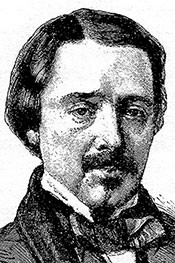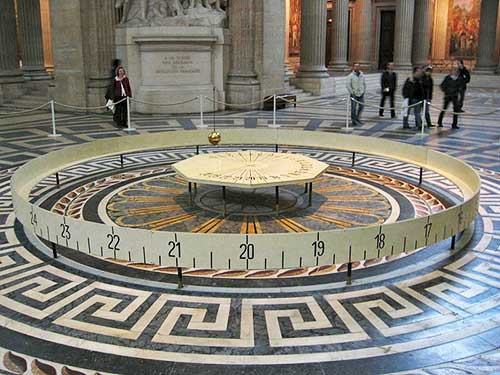Léon Foucault — Science Communicator
Bill Nuttle · 
Jean Bernard Léon Foucault, physicist, was born in Paris on September 18, 1819, and he died there on February 11, 1868. Foucault was a gifted experimentalist. He invented the gyroscope, measured the speed of light, improved instruments used in microscopy and astronomy, and applied the new technology of photography to science.i However, these achievements would have gone unrecognized by Foucault's more theory-minded contemporaries if not for his success in communicating developments in science to the general public.
Foucault's entry into a scientific career nearly ended in frustration. Foucault was always an indifferent student, and his teachers at the rigorous Collége Stanislas considered him to be something of a slacker. But from the age of thirteen Foucault displayed a keen interest in technology and a remarkable ability to construct things with his own hands. Seeking to build on these talents, Foucault's mother pushed him to train as a surgeon. These plans came undone in medical school when it became clear that Foucault could not stand the sight of blood, and he also did not like to be around sick people very much. Fortunately, one of his professors, Alfred Donné, hired Foucault to assist with a course on microscopy. This was his start as a hands-on experimental scientist.
Foucault's association with Donné also launched his career as a science communicator. As science editor for the influential newspaper, the Journal de débats, Donné reported on the latest developments in science to the general public. When Donné retired, Foucault assumed his role as the popular voice of science in Paris. This was around the middle of the 19th century during a revolution in science and technology was transforming Paris, France, and the world beyond. Through his lively reports on weekly meetings of the Academy of Sciences, Foucault soon had the attention of a devoted public audience as well as the scientific elite, who were the frequent subject of his sometimes unexpectedly frank commentary.
Wide public acclaim for Foucault's work as a scientist came in response to an experiment conceived entirely on his own and carried out under his own initiative. Using only a pendulum, one of the oldest instruments in the physicist's toolbox, Foucault was able to demonstrate conclusively what had been once one of science's most controversial assertions - that the Earth spins on its axis. In February 1851 Foucault had worked out the kinks, and he invited the scientific community to view a demonstration in the Paris Observatory. His printed invitation read simply, "You are invited to come see the Earth turn, tomorrow, from three to five, at Meridian Hall of the Paris Observatory."ii

The elite members of the Academy who showed up at the appointed hour may have been puzzled by the spare display that Foucault had arranged. Suspended from an 11-meter long wire, attached to the ceiling in the middle of the room, was a perfectly formed brass sphere weighing five kilograms (about eleven pounds).iii A thin cord attached to one wall held the pendulum to one side of the room. At the appointed hour Foucault made some introductory remarks and applied a lit match to the cord, which burned through immediately.
Released from the cord's restraint, the brass sphere swung gracefully to the other side of the room. Then, reversing direction, the sphere retraced its path back to the point of release - but not exactly. At the end of the return path the sphere was slightly to the left, shifted in a clockwise direction around the room from where it had started six and a half seconds earlier. After its next passage across the room and back the sphere had shifted slightly further clockwise around the room, and so on with each successive swing. To the observers it appeared at first that the plane described by the sweeping arc of the pendulum was rotating slowly. But, of course the plane of the pendulum was not moving at all; it was the floor of the Meridian Hall that was rotating beneath it. As the full implications of what they were seeing sunk in, Foucault's guests had the eerie sensation of the Earth moving beneath their feet.
Although Foucault's experiment appears simple, its successful execution depends on careful preparation. The influence of extraneous factors can confound the results if the experiment is approached casually. All present that day could see the painstaking care with which Foucault had constructed this apparatus to eliminate these extraneous factors. The brass sphere was perfectly symmetrical. The point of attachment to the ceiling allowed the cable to swing freely in any direction. And the method of releasing the pendulum assured that at the start there was no tendency for the pendulum to deviate in its path. No one doubted that they were seeing the Earth rotate beneath the pendulum.
However, for some of the academicians who witnessed that first demonstration, Foucault's pendulum experiment was most disturbing. The experiment proved nothing new; yet it challenged everything. Everyone already knew that the Earth rotates on its axis. However, several eminent members of the Academy, notably the mathematicians Cauchy and Poisson, had argued from first principles that the Earth's rotation could not produce the phenomenon that was plainly occurring. Foucault's pendulum experiment appeared to undermine the mathematical foundations that members of the Academy had carefully erected to support the sciences of physics and astronomy.iv For this service to theoretical science, Foucault would receive no gratitude from the Academy.
Unconcerned by these theoretical issues, the public was enthralled. Emperor Napoleon III decreed that Foucault's experiment be displayed publicly under the dome of the Panthéon in Paris,v and in 1855 Napoleon appointed Foucault to the position of physicist attached to the Paris Observatory. London's Royal Society awarded him the prestigious Copley Medal that same year. Finally, in 1865 the Academy of Sciences elected Foucault as a member. For Foucault, an experimentalist lacking the theoretical credentials most valued by members of the Academy, this honor was the result of his incomparable ability at communicating science to the public.
i Gillispie, C.C., Holmes, F.L., and N. Koertge (eds), 2008. Complete Dictionary of Scientific Biography [electronic resource]. Scribner's, Detroit.
ii Aczel, A.D., 2003. Pendulum: Léon Foucault and the Triumph of Science. Simon & Shuster, New York.
iii Foucault's original pendulum is on display at the Musée des arts et métiers, in Paris.
iv Aczel (2003).
v A replica of Foucault’s pendulum experiment can be seen under the dome of the Panthéon in Paris, in many science museums around the world, and sometimes in a stairwell at the New Jersey Institute of Technology [accessed 17 Mar 2011; http://jonathan.lansey.net/pastimes/pendulum2/index.html].

